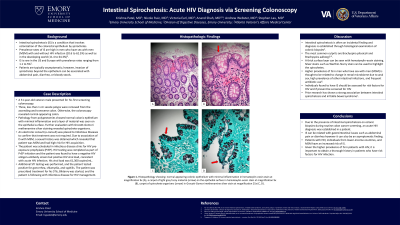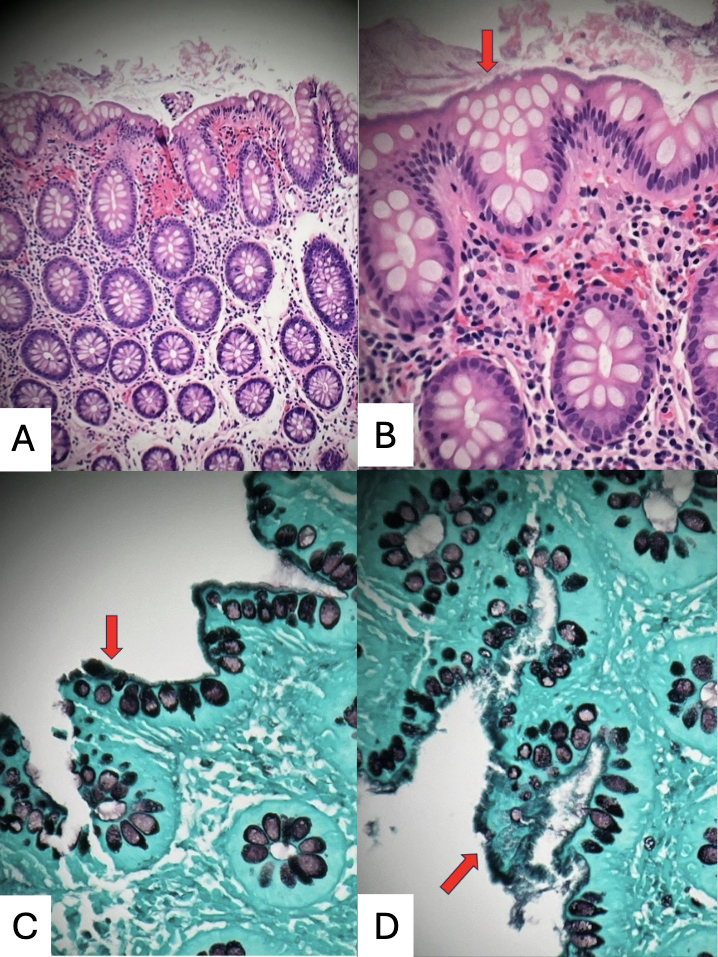Tuesday Poster Session
Category: Colon
P3713 - Intestinal Spirochetosis: Acute HIV Diagnosis via Screening Colonoscopy
Tuesday, October 29, 2024
10:30 AM - 4:00 PM ET
Location: Exhibit Hall E

Has Audio

Krishna Patel, MD
Emory University School of Medicine
Atlanta, GA
Presenting Author(s)
Krishna Patel, MD, Nicole Ruiz, MD, Victoria Earl, MD, Anand Shah, MD, Andrew Webster, MD, Stephen Lau, MD
Emory University School of Medicine, Atlanta, GA
Introduction: Intestinal spirochetosis (IS) is a condition that involves colonization of the colorectal epithelium by spirochetes—the most common culprits are Brachyspira pilosicoli and Brachyspira aalborgi. Prevalence rates of IS are high in homosexual men with and without HIV infection (20.6 to 62.5%) as well as in the developing world (11.4 to 64.3%). IS is rare in the US and Europe with prevalence rates ranging from 1.1 to 5%. Patients are typically asymptomatic; however, invasion of spirochetes beyond the epithelium can be associated with abdominal pain, diarrhea, or bloody stools. We present a unique case of IS that was incidentally found on screening colonoscopy and led to a new diagnosis of acute HIV infection.
Case Description/Methods: A 51-year-old veteran male presented for his first screening colonoscopy; three, <5 cm sessile polyps were removed from the ascending and transverse colon. Otherwise, the colonoscopy revealed normal-appearing colon. Polyp biopsies showed normal colonic epithelium with minimal inflammation and a layer of material was seen on the epithelial surface. Further evaluation with Grocott-Gomori methenamine silver staining revealed spirochete organisms. Given the evidence of spirochetes, the patient was seen by infectious diseases and a thorough history taking was done. The patient was homosexual and had a history of high-risk sexual behavior. Due to the patient’s history, HIV testing was completed, and the patient was diagnosed with acute HIV infection. His viral load was 61,300 copies/mL. The patient was otherwise asymptomatic and referred to infectious diseases for follow-up. A month after his colonoscopy, the patient had sexual intercourse with a male partner and developed urethritis. STI testing was done, and the patient tested positive for gonorrhea, chlamydia, and syphilis. At his outpatient follow-up, the patient was prescribed treatment for his STIs and Biktarvy was started.
Discussion: IS is often an incidental finding and diagnosis is established through histological examination of colonic biopsies. A thick surface layer is seen with hematoxylin-eosin stain; silver stains can be used to highlight the spirochetes. Given the higher prevalence of IS in patients with HIV, it is important to obtain a thorough history in patients who have risk factors for HIV infection. Higher prevalence of IS in homosexual men is thought to be related to change in rectal microbiome due to anal sex, high prevalence of other intestinal infections, and frequent antibiotic use.

Disclosures:
Krishna Patel, MD, Nicole Ruiz, MD, Victoria Earl, MD, Anand Shah, MD, Andrew Webster, MD, Stephen Lau, MD. P3713 - Intestinal Spirochetosis: Acute HIV Diagnosis via Screening Colonoscopy, ACG 2024 Annual Scientific Meeting Abstracts. Philadelphia, PA: American College of Gastroenterology.
Emory University School of Medicine, Atlanta, GA
Introduction: Intestinal spirochetosis (IS) is a condition that involves colonization of the colorectal epithelium by spirochetes—the most common culprits are Brachyspira pilosicoli and Brachyspira aalborgi. Prevalence rates of IS are high in homosexual men with and without HIV infection (20.6 to 62.5%) as well as in the developing world (11.4 to 64.3%). IS is rare in the US and Europe with prevalence rates ranging from 1.1 to 5%. Patients are typically asymptomatic; however, invasion of spirochetes beyond the epithelium can be associated with abdominal pain, diarrhea, or bloody stools. We present a unique case of IS that was incidentally found on screening colonoscopy and led to a new diagnosis of acute HIV infection.
Case Description/Methods: A 51-year-old veteran male presented for his first screening colonoscopy; three, <5 cm sessile polyps were removed from the ascending and transverse colon. Otherwise, the colonoscopy revealed normal-appearing colon. Polyp biopsies showed normal colonic epithelium with minimal inflammation and a layer of material was seen on the epithelial surface. Further evaluation with Grocott-Gomori methenamine silver staining revealed spirochete organisms. Given the evidence of spirochetes, the patient was seen by infectious diseases and a thorough history taking was done. The patient was homosexual and had a history of high-risk sexual behavior. Due to the patient’s history, HIV testing was completed, and the patient was diagnosed with acute HIV infection. His viral load was 61,300 copies/mL. The patient was otherwise asymptomatic and referred to infectious diseases for follow-up. A month after his colonoscopy, the patient had sexual intercourse with a male partner and developed urethritis. STI testing was done, and the patient tested positive for gonorrhea, chlamydia, and syphilis. At his outpatient follow-up, the patient was prescribed treatment for his STIs and Biktarvy was started.
Discussion: IS is often an incidental finding and diagnosis is established through histological examination of colonic biopsies. A thick surface layer is seen with hematoxylin-eosin stain; silver stains can be used to highlight the spirochetes. Given the higher prevalence of IS in patients with HIV, it is important to obtain a thorough history in patients who have risk factors for HIV infection. Higher prevalence of IS in homosexual men is thought to be related to change in rectal microbiome due to anal sex, high prevalence of other intestinal infections, and frequent antibiotic use.

Figure: Histopathology showing: normal appearing colonic epithelium with minimal inflammation in hematoxylin-eosin stain at magnification 9x (A), a carpet of light grey fuzzy material (arrow) on the epithelial surface in hematoxylin-eosin stain at magnification 9x (B), carpet of spirochete organisms (arrow) in Grocott-Gomori methenamine silver stain at magnification 25x (C, D).
Disclosures:
Krishna Patel indicated no relevant financial relationships.
Nicole Ruiz indicated no relevant financial relationships.
Victoria Earl indicated no relevant financial relationships.
Anand Shah indicated no relevant financial relationships.
Andrew Webster indicated no relevant financial relationships.
Stephen Lau indicated no relevant financial relationships.
Krishna Patel, MD, Nicole Ruiz, MD, Victoria Earl, MD, Anand Shah, MD, Andrew Webster, MD, Stephen Lau, MD. P3713 - Intestinal Spirochetosis: Acute HIV Diagnosis via Screening Colonoscopy, ACG 2024 Annual Scientific Meeting Abstracts. Philadelphia, PA: American College of Gastroenterology.
